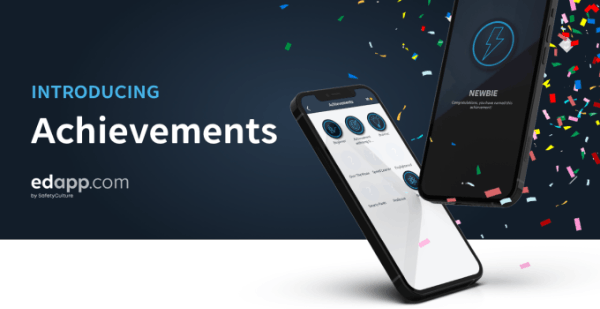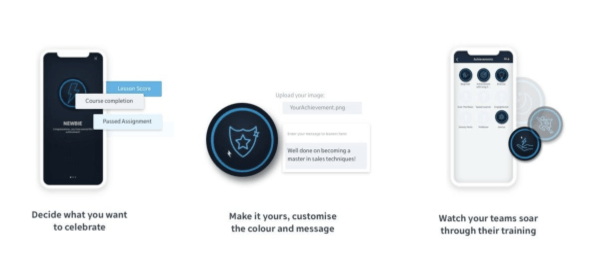Microcredentials for Enterprise

By definition, a microcredential is a mini-qualification that demonstrates knowledge, skills, or experience. In terms of employee training, microcredentials are an easy way to recognize mastery in a particular subject, which fits perfectly into a microlearning format. Could an online achievement feature icon like this, along with a few words of praise, make a significant difference in a trainee’s motivation and future learning? The research shows that it would.
Sign up for Free and Start Using The Best LMS to Award Your Employees
Microcredentials as symbolic awards
Just to be clear, we are not speaking about employee rewards that have any kind of “real” incentives such as gifts, vouchers, or any other type of financial compensation. These awards don’t have an impact on future career opportunities or advancement. In addition, any increase in status is limited to the receivers themselves and their peer community. In short, they are just symbolic proof of achievement.
However, an increase in volunteer retention has been seen in a recent study where Wikipedia volunteers continued volunteering for longer as a result of symbolic awards. This positive influence continued for four quarters after volunteers received their awards.
Other studies have shown the same effect for paid employees in a variety of organizations. If you are looking for a “by how much” estimate, one experiment reported a 12 percent increase in worker performance on average. Not a bad result for basically zero investment to gain increased volunteer retention!
Why are microcredentials effective?
Microcredentials can be likened to signals that almost everyone sees as positive. To make sure we’re on the same page, I’m defining a “signal” as “something that gives us non-verbal (not spoken) information”. Sometimes, the information from a signal is confusing depending on who we are. For example, quite a few of us symbolize “no” by shaking our heads from side to side, left to right. However, many others use a single “head up” movement, similar to our “yes”.
In that sense, using microcredentials taps into powerful signals which send messages of success to your trainees and their community:
- People who receive microcredentials identify more with the group which gave them. In our example in the section above, it was Wikipedia. In your case, it will be your organization.
- Online communities are partially measuring “status and reputation, recognition, and evaluation potential” via such awards. In other words, the more of these awards you have, the “better” you are thought to be.
Advantages of Achievements as microcredentials
At the moment, EdApp’s Achievement feature is the world’s first-ever, customizable achievements feature for any learning platform. This feature was created to enable your enterprise to make good use of symbolic awards.

While there are tons of symbolic award icons floating around on the internet that you can copy/paste or do minimal edits (many of them for free including all usage rights), you must consider the many benefits of being able to fully customize awards. This is because these awards can reflect the branding of your enterprise, so they are “official”. They are also part of your learning management system (LMS) which makes them integral to the package—important like the training, not an afterthought or a cute add-on. You make the rules about who gets what when, so the awards speak to the vision of your organization.
Best practices for customizing microcredentials
Take advantage of the customization possibilities of the EdApp LMS Achievement Feature to create motivating awards. One way, as I mentioned before, is to match the branding of your organization. While that is important and may be your final decision, there is much more to the psychology of color.
Warm vs. Cool colors
Recent research investigated memory recognition and recall during language learning. Learners who received words and phrases on colored paper (in this case, yellow) tested better than learners who received the same words and phrases on white paper.
One point worth noting is that the learners in the above study were all male. Some evidence suggests that there may be gender differences with respect to color and memory. In other words, warm colors would be used for males while cool colors would be used for females. This needs to be checked further but is something to keep in mind.
Use red with caution
The color red is associated with mind-body stimulation. It energizes, helping people to respond more quickly and more forcefully.
And yet...red is also associated with failure, especially with regard to test-taking.
Test takers were shown colored numbers shortly before a test. There were three groups: those shown numbers colored red, those shown numbers colored green, and those shown numbers colored black. Those who saw numbers colored red performed 20% lower than those in the other two groups.
So, perhaps using red is not the best choice for awards from a learning platform.
Colors and culture
The same color can mean different things in different cultures. The classic example is white: a symbol of mourning (grief, sadness) in many Eastern cultures but a symbol of purity or goodness in many Western ones. As a result, many Indian and Chinese brides will not wear white like their US counterparts.
A less well-known example is green. For many in the west, green symbolizes progress, luck, and the environment. In Mexico, it represents patriotism and independence. However, in China and Indonesia, green symbolizes infidelity. In South America, this color represents death.
When choosing colors for your achievement, consider color as a whole in addition to the ones in your branding.
Create your first Achievement
If you’re not already on a paid plan, you can access the feature as part of the free 1-month trial that you can easily access in EdApp LMS’s Engagement tab. The step-by-step guide can be found on EdApp’s support page.

We’d love you to stay in touch!
Please reach out to us at hello@edapp.com. We’re looking forward to your feedback and enhancement requests.
Outside sources:
https://pubsonline.informs.org/doi/pdf/10.1287/mnsc.2016.2540
https://www.jstor.org/stable/41237198
https://sfleducation.springeropen.com/articles/10.1186/s40862-020-00098-8
https://www.verywellmind.com/color-psychology-2795824
https://doi.apa.org/doiLanding?doi=10.1037%2F0096-3445.136.1.154
https://eriksen.com/marketing/color_culture/
https://www.instituteofhospitality.org/knowledge/management-guides/
https://www.fil.ion.ucl.ac.uk/spm/covid-19/forecasting/
https://www.sciencedirect.com/science/article/pii/S0278431920304096
https://www.ncbi.nlm.nih.gov/pmc/articles/PMC7528873/
Author
